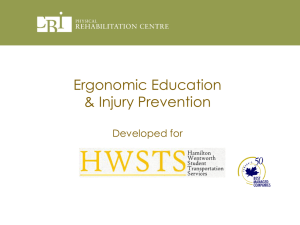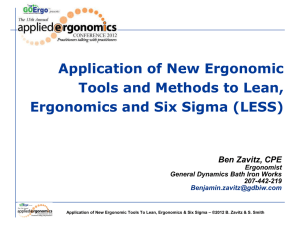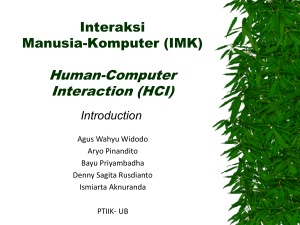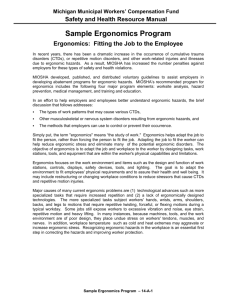PE-Laura
advertisement
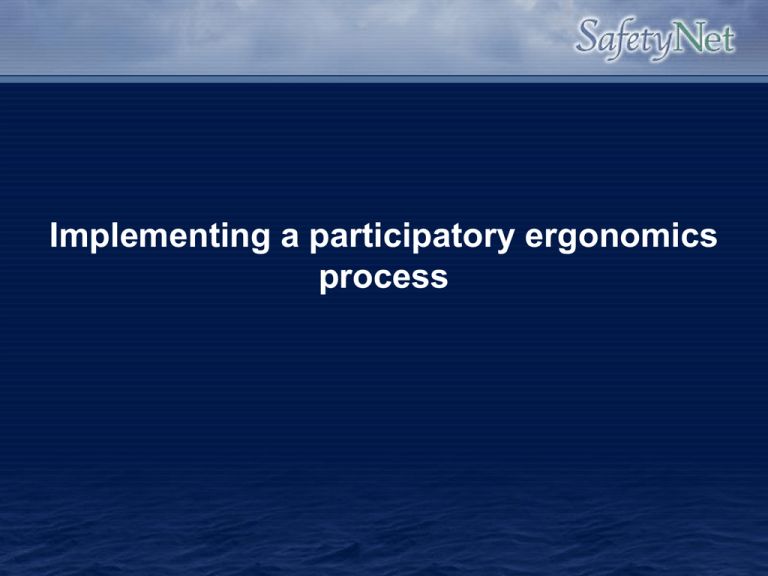
Implementing a participatory ergonomics process Overview • • • • • Traditional Ergonomic Practice PE definition/background Who is involved in PE programs PE in small workplaces Success Factors for Organizational Change • Barriers to the PE process • PE Blueprint Traditional ergonomic practices • Traditional Intervention Approaches – Fit a task/workspace to a worker – Recognition of risk (WRMSD’S) – Employ guidelines, laboratory findings, statistical modeling – Notion of “accidents” has changed – (Typically) not reiterative and often does not consider how changes create problems upstream/downstream • Effective in creating a problem solving culture? Failure of traditional approach: –NOT poor science –Ergonomic information (KNOWLEDGE) is not being properly adapted and applied Carrivick, Lee, Yau, & Stevenson (2005) How do we adapt & apply this ergonomics knowledge? • Participatory ergonomics represents an intervention style to work within a systemic approach to ergonomics – (Antle, 2008) Background on PE Rivilis et al., (2006): • PE interventions/programmes are used to reduce work related musculoskeletal disorders in workplaces • Grew out of quality circle experiences in Japan & participatory workplace design processes in Northern Europe and North America in the 1980’s Background on PE • Supported by unions, health and safety sectoral agencies, and health and safety associations – (Rivilis et al., 2006) • PE programs can be implemented as part of an organizations constant improvement process and should be budgeted and evaluated PE Programs • Improved ergonomics can lead to increased productivity • Reported outcomes from participatory ergonomics interventions include: – decreased injury incidence and lower compensation costs (Laing et al., 2005) PE Definitions The involvement of people in planning and controlling a significant amount of their work activities, with sufficient knowledge and power to influence both processes and outcomes in order to achieve desirable goals. Wilson & Haines (1997) PE Definitions • Participatory Ergonomics is the adaptation of the environment to the human (ergonomics) together with the proper persons in question (participants) – Vink (2005) • Practical ergonomics is necessary with actors in problem solving – Kuorinka (1997) Participatory Ergonomics Antle (2008) PE Definitions • There is no common consensus on a definition of PE (Antle, 2008) • But in all PE descriptions there is one common component- the involvement of stakeholders in the process. – Failure to involve these individuals may lead to their negative interpretation of the need for an intervention Who is involved in PE programs? Participatory Ergonomics • PE requires key company stakeholders to be involved in the intervention – at all stages of the process – They account for the traditional ergonomic measures, as well as the organizational and employee/management factors – Participation can either be direct or representative • Antle (2008) Participatory Ergonomics • In implementing effective ergonomics, we cannot focus on technology alone. We must understand the context in using comprehensive management concepts. Vink et al. (2008) • Capturing knowledge must account for social and organizational factors Kuorinka (1997); Laitinen et al. (1998) Participatory Ergonomics • An effective PE program encourages workers to identify the hazards or risk factors in their workplace – Risk can be shaped by different workplace components (multidimensional in nature) • Those related to the individual job • Those related to worksite environment • Those related to organizational issues – Cann et al. 2006 • In a 2008 study, Vink et al. theoretically proposed the different levels of involvement of participants in each step of a PE process. Participatory Ergonomics: Who is involved? Vink et al. (2008) • Top Management • Middle Management • Employee • Ergonomist • Designer • Internal Staff Vink et al. 2008 Top Management: Step 1 Middle Management: Steps 1, 4 Employee: Steps 2, 3, 4, 6, 8, 9 Ergonomist: Steps 2, 3, 5 Designer: Steps 3, 5, 7 Participatory Ergonomics Vink et al. (2008) results: • Middle management also involved in implementation • Employees also involved in adjustment • Ergonomists role limited in later stages such as adjusting and implementation Cann et al. (2006): Lay versus expert understandings of workplace risk in the food service industry: A multi-dimensional model with implications for participatory ergonomics How do perceptions differ? • Cann et al. (2006) – Explored the understandings of risk as felt by food service workers and how these compare with an “expert” in risk assessment • They note that the risk literature usually focuses on the evaluation of trained experts Cann et al. (2006) findings: • Ergonomists may be insufficient for successful workplace change and intervention • Workers are knowledgeable and their knowledge is a result of experience • Workers identified the same risks as the ergonomist just in more detail How can we train those involved in PE programs? • Can take several forms • Be careful with media selection – Lectures vs. Video/computer based learning – Hands on learning • Employees should feel as though they are active part of the program Success Factors for Organizational Change Success Factors for Organizational Change • The employment of long-term strategies for the company and the ability to make the necessary resources available • Adequate participation of individuals and groups affected by the changes • Consideration of impact of company’s or plant’s culture – Zink et al. (2008) Success Factors for Organizational Change • Coherence between different change initiatives • Emphasis on structures and behaviours considering the interdependencies between them • Change initiatives seen as evolutionary process but not as time-limited programs – Zink et al. (2008) PE factors for success • Literature identifies the several PE requirements – • Koningsveld, Dul, Van Rhijn, & Vink, 2005; de Looze, Urlings, Vink, Van Rhijn, & Miedema, 2001; Haines,Wilson, Vink, & Koningsveld, 2002; Saleem, Kleiner, & Nussbaum, 2003 Existence or absence of these factors determine the success of the intervention and long-term improvement of ergonomics/OHS capacity at the company Common Framework Success Factors 1. Identifying the involvement of key personnel; developing a steering committee 2. Having a PE trained ergonomic facilitator 3. Having participation of employees from all levels of the organization in as direct a manner as possible 4. Having strong management commitment 5. Focusing on employees satisfaction, production factors and other such outcomes, not just health implications 6. Using a step-wise strategy for the project 7. Ensure proper tools and equipment are available PE in small workplaces-how can we successfully implement changes? Participatory Ergonomics in Small Workplaces • Kogi (2008) reviewed the use of trainers in helping local people in small work environments and the improvements they can help make in different work scenarios Kogi (2008) Kogi (2008) • Programs dealing with work- related risks were organized according to the target groups – Risks addressed were • • • • Needle stick injuries MSD Mental stress situations Irregular hours/overwork situations • WISE training programs applied to small construction sites and home workplaces – Trainers played crucial role in facilitating learning of local good practice, low cost ideas, and follow up activities – Similar roles played in WIND programs Kogi (2008) • Trainers in these programs contributed to the adjustment of training materials to local conditions through the observation of local good practices and photographic examples Kogi (2008) • Second stage of facilitation was concerned with the planning of immediate improvements – Planning done by participating managers, workers or farmers themselves *CRUCIAL in each program* Kogi (2008) Kogi (2008) Effects of Participatory steps: • Practical improvements had been achieved in work and life conditions – Improvements in • Reduced injury risks • Work environment – Lighting, ventilation machine guarding, and chemicals handling • Reduced physical and muscular loads Kogi (2008) Concluding remarks: • A trainer’s facilitative role is more effective when these support functions are followed: 1) Building local initiative for action 2) Focus on practical options 3) Conformation of benefits of the improvements achieved through feedback Barriers to the PE process Key Barriers to PE Process Three issues in PE process noted by Institute for Work and Health (2009): 1) Having support for PE program from the organization 2) Having resource commitment from the organization 3) Having open communication about the PE program Barriers to PE Process • Cann et al. (2006) – A key barrier to shared knowledge is not due to expertise, but the inability or unwillingness to incorporate different types of knowledge and expertise to accomplish a common goal What happens when PE interventions are not considered successful? When PE Interventions Are Not Successful • Laing et al. (2007) investigated the purpose of a PE programme in reducing WMSD – Wanted to assess whether an intervention influenced pain severity based on aspects of the change process – Used a sister plant in the corporation as a referent group Laing et al. (2007) – There was an increase reported in enhanced communication regarding ergonomic issues – However, when the final assessment took place there was no real change in worker perception or pain severity..... • What went wrong? Laing et al. (2007) • Possible Explanations: – Worker input – Limited intervention intensity – Context/Co-intervention differences between the two plants – Lack of sensitivity/specificity in psychosocial measures used Laing et al. (2007) • Worker input – Improved communication dynamics may be a requirement for changes to occur in worker perception of workplace decision latitude and influence • May not be sufficient enough- Why? – Workers may perceive that their input is ignored • This may lead to decrease in decision latitude Laing et al. (2007) • Limited intervention intensity – Intervention period may have been too short (10 months) – Lack of commitment by ECT team • Logo/participation in 1 minute survey – Use of representative participation approach • Employees may not have felt involved in process of change Laing et al. (2007) • Context/Co-intervention differences between the two plants – A history of mistrust and nonparticipatory practices between labour and management existed at the intervention plant • New management 4 months into intervention period Laing et al. (2007) • Lack of sensitivity/specificity in psychosocial measures used – Psychosocial exposures measures may not have been sensitive enough for the specific changes involved with the particular intervention • More thoughts need to be given to tool development used to measure outcomes affected by work PE Blueprint PE Blueprint • A facilitators guide for implementing a successful PE program as part of an organizations health and safety program • Establishes the groundwork to gain management support, set up a PE change team and initiate basic training in ergonomics PE Blueprint • Has an Ergonomic Process and a Health and Safety Process • Health and Safety Process – Is the organizational structure that supports the ergonomic process Wells, Frazer, Norman, Laing, 2001 PE Blueprint Ergonomic Process (2 Cycles) • Reactive Cycle: – Facilitator identifies risk, evaluates priorities, proposes solutions, implements and evaluates a prototype in order to adopt solutions • Proactive Cycle – Uses feedback from previous changes to ensure that ergonomic principles are used in purchasing and design of new equipment PE Blueprint Ergonomic Process • These processes are complementary and required • Both of these processes use a common solution building, evaluation, and adoption approach PE Blueprint: Startup Reactive Process Reactive Process Phase 1: • Opportunities for improvement – Identify jobs, tasks or processes where workers experience greater rates of MSD or other indicators of poor ergonomic quality – Then integrate this data to determine which jobs may need further ergonomic investigation and assessment Reactive Process Phase 2 • Assess Ergonomic risk factors and prioritize jobs for improvement – Prioritize ergonomic interventions for the jobs identified in previous step Reactive Process Phase 3 • Build Solutions – Develop a prototype/trial solution to address the risks identified in the previous step Reactive Process Phase 4 • Prototype Implementation – Implement solutions on a small scale or proactively as a computer simulation where possible • This can judge its ergonomic quality and interactions with other equipment and processes Reactive Process Phase 5 • Prototype evaluation – Estimate the ergonomic quality of the prototype solution Reactive Process Phase 6 • Implement Solution – Allow for the smooth introduction of the solution after prototype trials – Continue monitoring the effect of the changes and still look for opportunities for improvement Proactive Approach Proactive Approach • Proactive Approach – Develops guidelines in all relevant departments • This aids to incorporate ergonomic information into decision making – Uses ergonomic tools • This allows prediction of the effects of design decision on human health and performance Proactive Approach • Proactive Approach – Commits resources/time • needed to incorporate ergonomic information into decision making – Develops future programs • Builds in a continuous improvement cycle based on improvement of existing design problems and feedback



